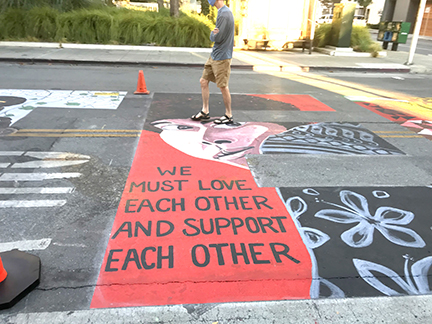
This story was originally printed by the Daily Post on Thursday. To get all of the local news first, pick up the Post in the mornings at 1,000 Mid-Peninsula locations.
BY EMILY MIBACH
Daily Post Staff Writer
A Santa Clara County judge issued a tentative ruling yesterday (March 2) in favor of the city of Palo Alto in a lawsuit filed by six of its police officers, who claim that a Black Lives Matter mural in front of City Hall was racist and offensive.
Judge Socrates Manoukian posted a ruling yesterday siding with the city’s request to throw out the lawsuit. The ruling isn’t final. The judge will hear from both sides one more time and could reverse himself.
Six officers sued the city saying they were harassed and discriminated against by the city, which commissioned a Black Lives Matter mural that depicted Assata Shakur. Shakur is a civil rights activist turned fugitive after she was convicted of killing a New Jersey state trooper in 1973.
The mural was painted on Hamilton Avenue just a month after demonstrations swept the country in response to the death of George Floyd in 2020. The lawsuit complained that a portion of the mural included part of the logo for the New Black Panthers, which has been identified by the Southern Poverty Law Center as a hate group.
Matthew McNicholas, a lawyer for the six officers, wrote in a Feb. 17 filing that the city sponsored “hate speech,” and it seriously affected the officers’ psychological wellbeing.
Was it a ‘hostile work environment’?
McNicholas argued that the mural created a “hostile work environment.”
But Judge Manoukian said that in order to come down on the side of the officers, they must show that the city took some sort of action against the officers, like demoting them. Simply annoying them doesn’t count.
Manoukian then cited McRae v. Department of Corrections and Rehabilitation, a 2006 state case, in which the court said “workplaces are rarely idyllic retreats, and the mere fact that an employee is displeased by an employer’s act or omission does not elevate that.”
The mural, Manoukian, doesn’t reach the threshold of creating a hostile workplace.
The officers also argued that the mural was an attack on their race, ethnicity or national origin.
Plaintiffs are racially diverse
The officers initially claim in their lawsuit that they are protected based on “race, ethnicity, and/or national origin.” But, Judge Manoukian points out that officers Michael Foley, Chris Moore and Julie Tannock are Caucasian. Eric Figueroa is Filipino and Caucasian. David Ferreira is Caucasian and Pacific Islander/ Asian and Robert Parham is Hispanic.
Since the officers are not all one race or ethnicity, Manoukian agreed with the city’s argument that “the only thing common to all the plaintiffs if that they are all police officers, but being a police officer is not a protected class.”
Manoukian said that if the officers had pointed out in their lawsuit that the “New Black Panthers are a hate group targeting all non-African Americans,” then he may have been included to agree that at least a portion of the mural was offensive.
However, the officers made that claim in their objection to the city’s request to throw out the lawsuit, not their lawsuit.
“There is nothing to suggest that the mural and its iconography was created in favor of one (protected) group over another,” Manoukian wrote.
The judge goes on to state that the city’s refusal to remove the mural was not based on “plaintiff’s race, ethnicity or some other protected classification.”
